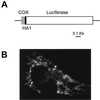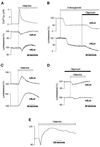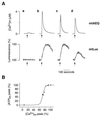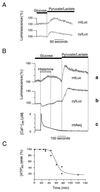Regulation of mitochondrial ATP synthesis by calcium: evidence for a long-term metabolic priming
- PMID: 10570154
- PMCID: PMC24146
- DOI: 10.1073/pnas.96.24.13807
Regulation of mitochondrial ATP synthesis by calcium: evidence for a long-term metabolic priming
Abstract
In recent years, mitochondria have emerged as important targets of agonist-dependent increases in cytosolic Ca(2+) concentration. Here, we analyzed the significance of Ca(2+) signals for the modulation of organelle function by directly measuring mitochondrial and cytosolic ATP levels ([ATP](m) and [ATP](c), respectively) with specifically targeted chimeras of the ATP-dependent photoprotein luciferase. In both HeLa cells and primary cultures of skeletal myotubes, stimulation with agonists evoking cytosolic and mitochondrial Ca(2+) signals caused increases in [ATP](m) and [ATP](c) that depended on two parameters: (i) the amplitude of the Ca(2+) rise in the mitochondrial matrix, and (ii) the availability of mitochondrial substrates. Moreover, the Ca(2+) elevation induced a long-lasting priming that persisted long after agonist washout and caused a major increase in [ATP](m) upon addition of oxidative substrates. These results demonstrate a direct role of mitochondrial Ca(2+) in driving ATP production and unravel a form of cellular memory that allows a prolonged metabolic activation in stimulated cells.
Figures





References
Publication types
MeSH terms
Substances
Grants and funding
LinkOut - more resources
Full Text Sources
Other Literature Sources
Miscellaneous

